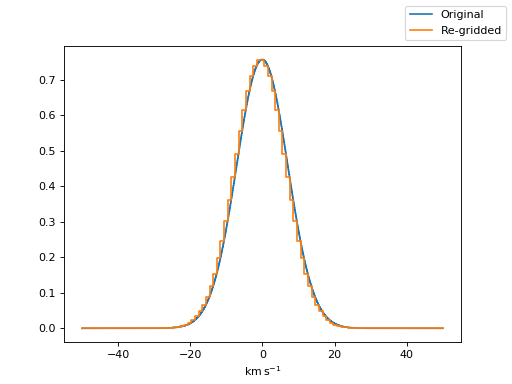Analysis¶
Spectacle comes with several statistics on the line profiles of models. These
can be accessed via the line_stats()
method on the spectrum object, and will display basic parameter information
such as the centroid, column density, doppler velocity, etc. of each line in
the spectrum.
Three additional statistics are added to this table as well: the
equivalent width (ew), the velocity delta covering 90% of the flux value
(dv90), and the full width half maximum (fwhm) of the feature.
>>> spec_mod.line_stats(x)
<QTable length=2>
name wave col_dens v_dop delta_v delta_lambda ew dv90 fwhm
Angstrom km / s km / s Angstrom Angstrom km / s Angstrom
bytes10 float64 float64 float64 float64 float64 float64 float64 float64
------- --------- -------- ------- ------- ------------ ------------------- ------------------ --------------------
HI1216 1215.6701 13.0 7.0 0.0 0.0 0.05040091274475814 15.21521521521521 0.048709144294889484
HI1216 1215.6701 13.0 12.0 30.0 0.0 0.08632151159859157 26.426426426426445 0.08119004034051613
The dv90 statistic is calculated following the “Velocity Interval Test”
formulation defined in Prochaska & Wolf (1997). In this case, the optical
depth of the profile is calculated in velocity space, and 5% of the total
is trimmed from each side, leaving the velocity width encompassing the central
90%.
Arbitrary line region statistics¶
It is also possible to perform statistical operations over arbitrary absorption or emission line regions. Regions are defined as contiguous portions of the profile beyond some threshold.
>>> from spectacle.modeling import Spectral1D, OpticalDepth1D
>>> import astropy.units as u
>>> from matplotlib import pyplot as plt
>>> import numpy as np
>>> from astropy.visualization import quantity_support
>>> quantity_support()
We’ll go ahead and compose a spectrum in velocity space of two HI line profiles, with one offset by \(30 \tfrac{km}{s}\).
>>> line1 = OpticalDepth1D(lambda_0=1216 * u.AA, v_doppler=7 * u.km/u.s, column_density=13, delta_v=0 * u.km/u.s)
>>> line2 = OpticalDepth1D("HI1216", delta_v=30 * u.km/u.s, v_doppler=12 * u.km/u.s, column_density=13)
>>> spec_mod = Spectral1D([line1, line2], continuum=1, output='flux')
>>> x = np.linspace(-200, 200, 1000) * u.km / u.s
>>> y = spec_mod(x)
Now, print the statistics on this absorption region.
>>> region_stats = spec_mod.region_stats(x, rest_wavelength=1216 * u.AA, abs_tol=0.05)
>>> print(region_stats)
region_start region_end rest_wavelength ew dv90 fwhm
km / s km / s Angstrom Angstrom km / s Angstrom
------------------- ------------------ --------------- ------------------- ----------------- --------------------
-12.612612612612594 48.648648648648674 1216.0 0.12297380252108686 46.44644644644646 0.056842794376279926
Plot to show the found bounds of the contiguous absorption region.
>>> f, ax = plt.subplots()
>>> ax.axhline(0.95, linestyle='--', color='k', alpha=0.5)
>>> for row in region_stats:
... ax.axvline(row['region_start'].value, color='r', alpha=0.5)
... ax.axvline(row['region_end'].value, color='r', alpha=0.5)
>>> ax.step(x, y)
(Source code, png, hires.png, pdf)

Re-sampling dispersion grids¶
Spectacle provides a means of doing flux-conversing re-sampling by generating a re-sampling matrix based on an input spectral dispersion grid and a desired output grid.
>>> from spectacle.modeling import Spectral1D, OpticalDepth1D
>>> from spectacle.analysis import Resample
>>> import astropy.units as u
>>> from matplotlib import pyplot as plt
>>> import numpy as np
>>> from astropy.visualization import quantity_support
>>> quantity_support()
Create a basic spectral model.
>>> line1 = OpticalDepth1D("HI1216")
>>> spec_mod = Spectral1D(line1)
Define our original, highly-sampled dispersion grid.
>>> vel = np.linspace(-50, 50, 1000) * u.km / u.s
>>> tau = spec_mod(vel)
Define a new, lower-sampled dispersion grid we want to re-sample to.
>>> new_vel = np.linspace(-50, 50, 100) * u.km / u.s
Generate the resampling matrix and apply it to the original data.
>>> resample = Resample(new_vel)
>>> new_tau = resample(vel, tau)
Plot the results.
>>> f, ax = plt.subplots()
>>> ax.step(vel, tau, label="Original")
>>> ax.step(new_vel, new_tau, label="Re-gridded")
>>> f.legend()
(Source code, png, hires.png, pdf)
